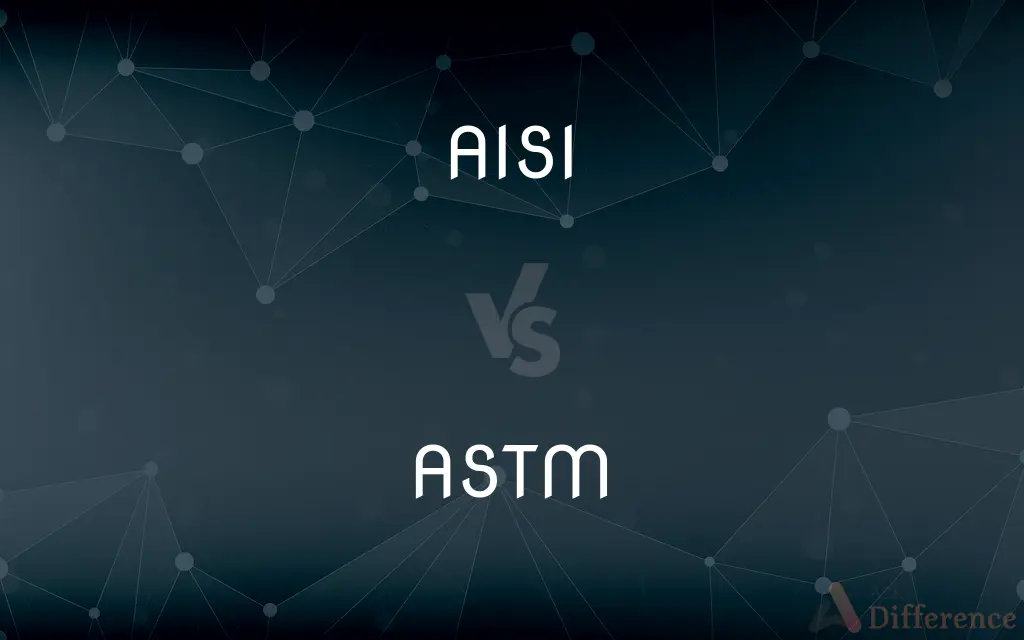AISI vs. ASTM — What's the Difference?
By Tayyaba Rehman — Published on December 11, 2023
AISI refers to the American Iron and Steel Institute, focusing on steel and iron standards, while ASTM is the American Society for Testing and Materials, covering diverse materials and testing standards.

Difference Between AISI and ASTM
Table of Contents
ADVERTISEMENT
Key Differences
AISI stands for the American Iron and Steel Institute. This organization is mainly concerned with the representation of iron and steel producers in North America. On the other hand, ASTM stands for the American Society for Testing and Materials, which is an international organization that develops and publishes standards for a wide range of materials, products, systems, and services.
The primary role of AISI is to promote the interests of the steel industry, ensuring its health and competitiveness. In contrast, ASTM is primarily focused on setting standards across multiple industries, ranging from metals to construction and consumer goods.
In terms of standards, when you come across an AISI designation for steel (e.g., AISI 304 for stainless steel), it mainly pertains to the chemical composition and some physical properties. ASTM, however, has standards that cover various aspects, including performance, production methods, and testing procedures.
Many professionals in the metallurgy field might use AISI standards for identifying steel and its properties. Meanwhile, engineers and quality assurance professionals might be more familiar with ASTM standards as they often use them for testing and quality control.
While AISI and ASTM are both crucial for their respective sectors, it's important to recognize their distinct focuses: AISI is more about the steel industry's interests, while ASTM encompasses a broader scope of standardization across various industries.
ADVERTISEMENT
Comparison Chart
Organization Full Name
American Iron and Steel Institute
American Society for Testing and Materials
Main Focus
Steel and iron standards
Standards for diverse materials & testing
Scope
North American steel industry representation
International standardization
Standard Example
AISI 304 refers to a type of stainless steel
ASTM A36 refers to a carbon structural steel
Usage
Identify steel & its properties
Testing and quality control standards
Compare with Definitions
AISI
AISI is an association representing steel producers.
The AISI conference discussed advancements in steel technologies.
ASTM
ASTM is a globally recognized leader in the development of international standards.
An ASTM certification indicates a product meets international quality standards.
AISI
AISI works to ensure the health and competitiveness of the steel industry.
AISI released a report on sustainable steel production practices.
ASTM
ASTM often provides methods to evaluate material properties.
The ASTM method for tensile testing determines material strength.
AISI
AISI is the acronym for the American Iron and Steel Institute.
The AISI sets standards for the steel industry.
ASTM
ASTM standards encompass diverse sectors from metals to consumer goods.
The ASTM standard for playground equipment ensures children's safety.
AISI
AISI classifies metals based on their composition.
AISI 316 stainless steel has molybdenum for better corrosion resistance.
ASTM
ASTM sets testing protocols for materials.
Manufacturers use ASTM standards to ensure product quality.
AISI
AISI standards often define the chemical makeup of steels.
The AISI 1040 designation specifies a certain carbon content.
ASTM
ASTM stands for the American Society for Testing and Materials.
The ASTM develops standards for various industries.
Common Curiosities
Which organization is more internationally recognized?
ASTM has a broader international recognition due to its diverse standards across industries.
What does AISI stand for?
AISI stands for the American Iron and Steel Institute.
Are AISI and ASTM the same?
No, while AISI focuses on steel and iron standards, ASTM covers diverse materials and testing standards.
Is AISI a global organization?
AISI primarily represents the North American steel industry.
What is the main focus of ASTM?
ASTM, the American Society for Testing and Materials, focuses on setting standards across various industries.
a metallurgist or a toy manufacturer?
A metallurgist would be more concerned with AISI due to its focus on steel standards.
Do engineers use AISI standards?
Engineers might use AISI standards when dealing specifically with steel and its properties.
Are ASTM standards legally binding?
ASTM standards are voluntary but can be referenced or included in regulations and contracts.
Does AISI deal with materials other than steel?
AISI primarily deals with steel and iron standards.
How does ASTM ensure the quality of a product?
ASTM sets testing and quality control standards that manufacturers can follow.
How are AISI steel grades determined?
AISI steel grades are often based on the metal's chemical composition.
Does ASTM deal with steel standards too?
Yes, ASTM has standards that pertain to steel, among many other materials.
How diverse are ASTM's standards?
ASTM standards cover multiple industries, from metals and construction to consumer goods.
Can I find safety standards in ASTM?
Yes, ASTM includes standards related to safety across various industries.
Who established the AISI and ASTM?
AISI was established by the steel industry in North America, while ASTM was founded by engineers and scientists for standardization purposes.
Share Your Discovery

Previous Comparison
Raw Sugar vs. Brown Sugar
Next Comparison
SO2 vs. SO3Author Spotlight
Written by
Tayyaba RehmanTayyaba Rehman is a distinguished writer, currently serving as a primary contributor to askdifference.com. As a researcher in semantics and etymology, Tayyaba's passion for the complexity of languages and their distinctions has found a perfect home on the platform. Tayyaba delves into the intricacies of language, distinguishing between commonly confused words and phrases, thereby providing clarity for readers worldwide.
















































